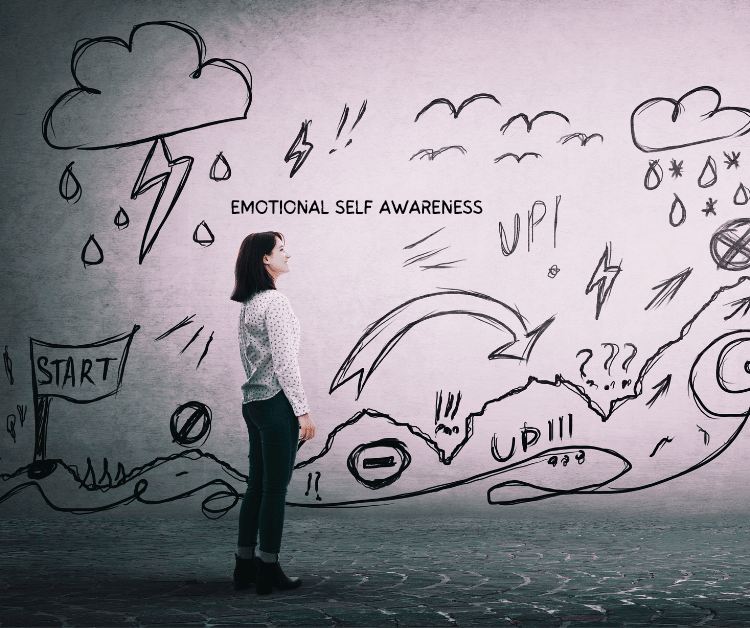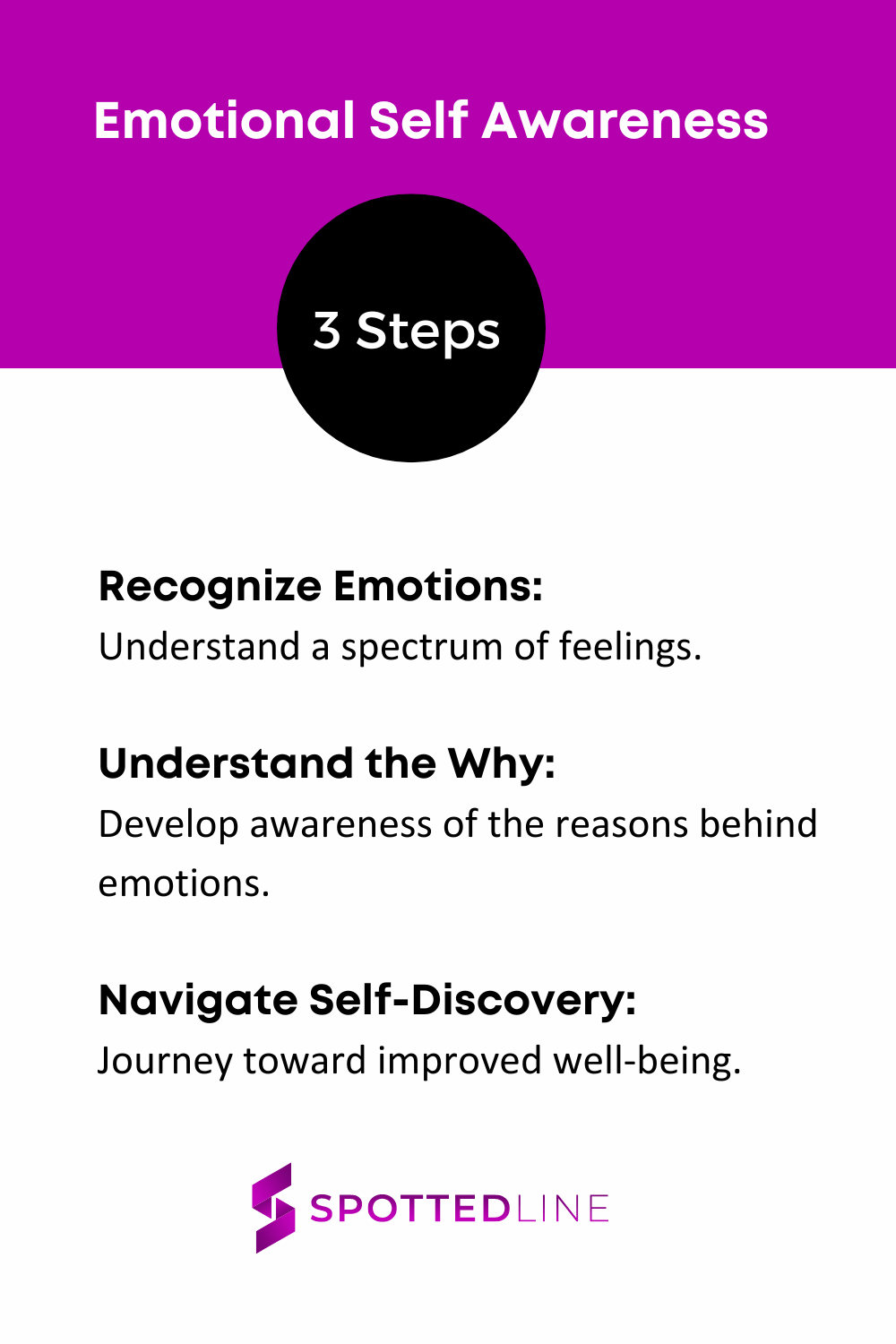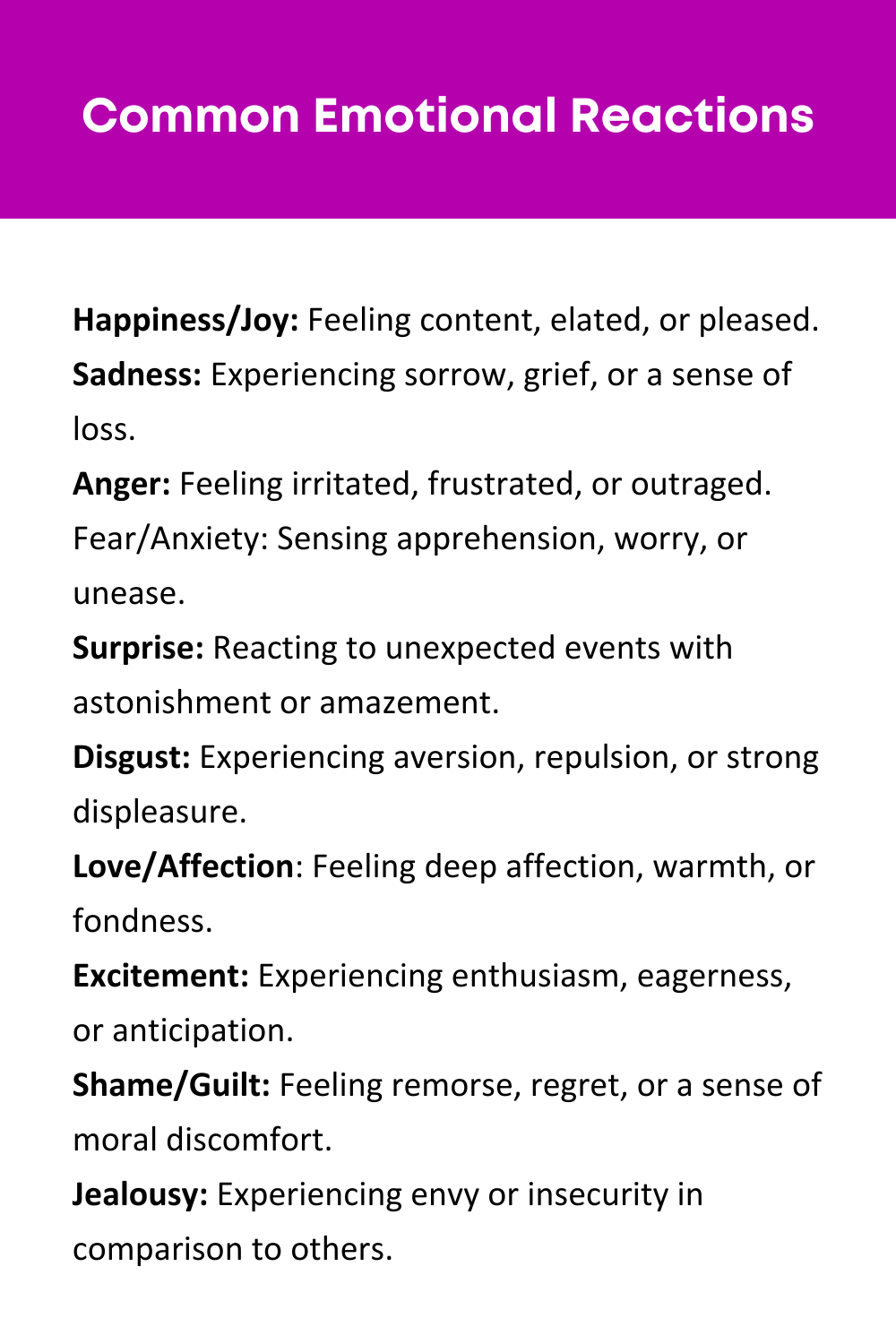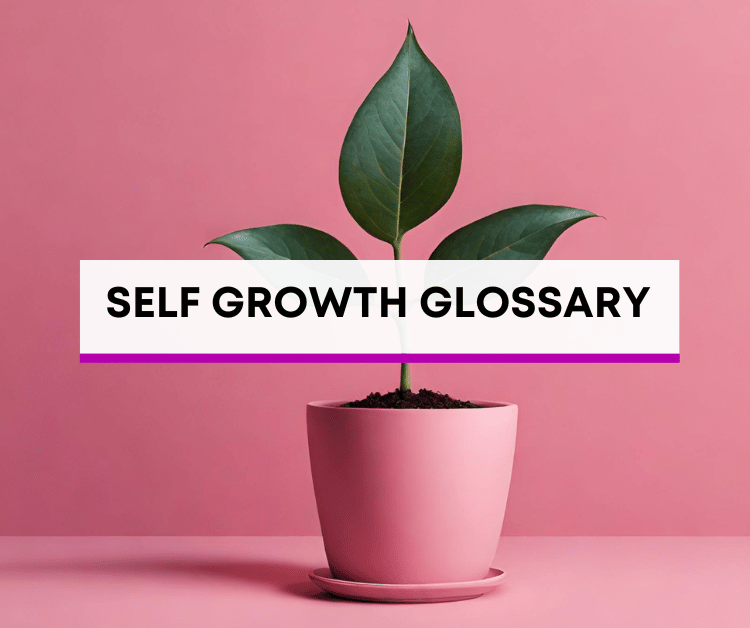
Welcome to a journey of self-discovery and emotional self awareness!
In this blog post, we’re diving into the heart of emotional self-awareness, unpacking its essentials with clarity and simplicity.
Join us as we explore the keys to identifying and labeling emotions, understanding triggers and patterns, and integrating these emotional experiences.
Whether you’re new to this path or a seasoned explorer, let’s navigate the landscape of self-awareness together, paving the way for improved mental well-being and a deeper connection with your emotional life.
Ready to embark? Let’s dive in!
What is Emotional Self Awareness?
Emotional self-awareness is understanding your own feelings—be it joy or sadness.
It’s like tuning into an emotional radio station, identifying the vibes of your day.
This journey is about recognizing and comprehending your emotions, navigating highs and lows for better communication and decision-making. It’s becoming your emotional expert, improving overall well-being.
*As an Amazon Associate, we earn from qualifying purchases at no additional cost to you.
- Recognize and understand a spectrum of emotions.
- Develop a deeper awareness of the why behind your feelings.
- Navigate the journey of self-discovery for improved well-being.
3 Ways to Improve Your Emotional Self Awareness

If you’re anything like most people, your emotions can get the best of you. (Especially if you’re the passionate type.) This is most common in the beginning stages of your career.
However, according to TalentSmart, approximately 90% of high-performing individuals in the workplace exhibit strong emotional intelligence, including emotional self-awareness.
The good news? If you’re passionate enough to care as much as you do, emotional self awareness can be easily master with these three steps.
1. Identify and Name Your Emotions.
2. Determine What Triggered the Emotion.
3. Determine What Your Emotional Response is Trying to Tell You About Your Identity and Needs.
1. Spot and Name Your Emotions
Think of your emotions like guests at a party. The easiest way to spot and name them is to play the host and introduce yourself.
Take a mental inventory and ask, “Who just walked through the door?”
Whether it’s Joy, Frustration, or a mix of both, giving them names makes the whole emotional gathering more recognizable.
It’s a straightforward approach—just like calling out names on a guest list—and suddenly, you’re navigating your emotional landscape with ease.
The Most Common Emotional Reactions
Emotional triggers are a widely recognized aspect of human psychology.
Here is a list of the most common emotional reactions to look for when it comes to emotional self awareness.
- Happiness/Joy: Feeling content, elated, or pleased.
- Sadness: Experiencing sorrow, grief, or a sense of loss.
- Anger: Feeling irritated, frustrated, or outraged.
- Fear/Anxiety: Sensing apprehension, worry, or unease.
- Surprise: Reacting to unexpected events with astonishment or amazement.
- Disgust: Experiencing aversion, repulsion, or strong displeasure.
- Love/Affection: Feeling deep affection, warmth, or fondness.
- Excitement: Experiencing enthusiasm, eagerness, or anticipation.
- Shame/Guilt: Feeling remorse, regret, or a sense of moral discomfort.
- Jealousy: Experiencing envy or insecurity in comparison to others.
Remember, emotions are complex and can often be a mix of these basic reactions. Individual experiences may vary, and it’s normal to have a range of emotions in different situations.
2. Spot What Made You React This Way - Identify the Emotional Triggers
When faced with an emotional response, think of it like detective work for your feelings.
Take a breather and ask yourself, “What just went down?” Consider the scene – who, what, when, where. Check your mental notes on thoughts and beliefs leading up to it.
Any déjà vu from the past? Patterns, anyone? It’s like figuring out the plot of your own emotional story.
The more you investigate, the better you get at spotting the triggers, making you the Sherlock Holmes of your own emotions.
- Pause and reflect on the emotional response.
- Explore recent events and interactions.
- Examine thoughts and interpretations.
- Consider connections to past experiences.
- Identify recurring patterns or themes.
- Ask why you reacted the way you did.
- Keep a journal to track emotions and events.
- Seek feedback from trusted individuals.
Common Emotional Triggers
Below is a list of common emotional triggers recognized by mental health professionals.
As someone managing symptoms from PTSD, my most common emotionals triggers are trauma reminders, uncertainty, unmet expectations, and criticism. But, like for everyone, the other triggers can creep up as well. Try to pick out your most common triggers and then keep reading for examples from work and at home.
- Criticism: feelings of defensiveness or inadequacy.
- Failure: emotions of disappointment or frustration.
- Conflict: triggers anger, resentment, or anxiety.
- Loss: profound grief, sadness, or loneliness.
- Change: induces stress, anxiety, or a sense of instability.
- Unmet Expectations: disappointment or frustration.
- Uncertainty: triggers anxiety or fear.
- Rejection: feelings of hurt, sadness, or low self-worth.
- Comparisons: jealousy, insecurity, or low self-esteem.
- Trauma Reminders: past traumas may resurface with certain stimuli.
Emotional Triggers at Work Examples
Criticism:
- Example: Getting some not-so-great feedback from your boss might make you feel a bit defensive or question your abilities.
Failure:
- Example: When a project doesn’t go as planned, it’s normal to feel disappointed or frustrated.
Conflict:
- Example: Having a disagreement with a coworker can stir up feelings of anger, resentment, or anxiety.
Loss:
- Example: Missing out on a promotion or facing setbacks in your career journey can bring on deep sadness or loneliness.
Change:
- Example: When things at work suddenly shift or there’s a new boss in town, it can make you feel stressed or uneasy.
Unmet Expectations:
- Example: Not getting the recognition you hoped for after putting in extra effort can be a real letdown.
Uncertainty:
- Example: When you’re not sure what’s expected of you at work or where your career is headed, it can be anxiety-inducing.
Rejection:
- Example: Being left out of a team activity or not getting chosen for a project can make you feel pretty low.
Comparisons:
- Example: Seeing others around you climb the career ladder faster might trigger feelings of jealousy or self-doubt.
Trauma Reminders:
- Example: If a certain work situation brings back memories of a past traumatic experience, it’s important to recognize and address those feelings.
Emotional Triggers at Home Examples
Criticism:
- Example: Receiving criticism from a family member about your choices might make you feel defensive or question yourself.
Failure:
- Example: Falling short of personal goals, like sticking to a fitness routine, can bring about feelings of disappointment or frustration.
Conflict:
- Example: Having a disagreement with a partner or family member may stir up feelings of anger, resentment, or anxiety.
Loss:
- Example: Experiencing a personal setback or the end of a relationship can lead to profound grief, sadness, or loneliness.
Change:
- Example: Navigating major life changes, like a move or family dynamics, can induce stress, anxiety, or a sense of instability.
Unmet Expectations:
- Example: Not meeting personal expectations, such as feeling unfulfilled in a hobby, can result in disappointment or frustration.
Uncertainty:
- Example: Facing uncertainty about the future, like job security or personal plans, can trigger anxiety or fear.
Rejection:
- Example: Feeling rejected or excluded in social circles or friendships can evoke feelings of hurt, sadness, or low self-worth.
Comparisons:
- Example: Comparing your personal life to others, especially on social media, might lead to feelings of jealousy, insecurity, or low self-esteem.
Trauma Reminders:
- Example: Certain situations at home, reminiscent of past traumas, may bring up old feelings and memories that need attention and care.
3. Understand Why You Feel That Way

Now that you’ve named the emotion and recognized the trigger, it’s time to self reflect to see what bigger issue it could be a part of. You can ask yourself these questions:
- Why do I care so much about this?
- Why does this make me… [ sad, happy, excited, mad, or overwhelmed?]
- What can I control on my end in the future to get a better emotional response.
Example of Emotional Self Awareness Reflection
Meet Erica, a go-getter at the office who’s always pushing herself to be her best.
She’s surrounded by colleagues who, while perfectly competent, take a more laid-back approach.
Sometimes, Erica can’t help but feel a bit frustrated or critical of their different work style.
It’s like she’s projecting her own drive onto them, getting a tad irritated when they don’t share the same level of ambition. I
t’s not that they dislike hard work; Erica might just be wrestling with her own high standards and expectations, and it shows when she sees a different approach around her.
Erica's triggers
In Erica’s situation, several emotional triggers are at play:
Criticism: Erica’s frustration and occasional criticism of her colleagues’ work style suggest a trigger related to how she perceives their approach.
Expectation Discrepancy: The difference in ambition and work ethic between Erica and her colleagues may trigger feelings of unmet expectations, contributing to her frustration.
Comparison: Erica’s tendency to compare her own drive with her colleagues’ more relaxed approach is a common trigger for feelings of jealousy, insecurity, or self-doubt.
Internal Standards: Erica’s high standards for herself, projected onto others, can be a trigger for frustration and disappointment when those standards aren’t met by her colleagues.
Healthy Ways to Respond to Workplace Triggers
For Erica, here are some down-to-earth ways to handle those workplace feelings:
Connect and Understand:
- Instead of getting frustrated, try to understand where your colleagues are coming from. Maybe they have a different approach that you haven’t considered.
Go Easy on Expectations:
- Ease up on expecting everyone to match your level of ambition. People bring different strengths to the table, and that’s okay.
Celebrate Everyone’s Style:
- Embrace the variety in how people work. It’s like a mixtape – different beats make the song more interesting.
Personal Growth Matters:
- Focus on your own growth rather than constantly comparing yourself. What are your personal goals? Work towards those.
Talk it Out:
- If something’s bugging you, have a chat with your colleagues. It’s like finding the right note in a song – communication makes everything smoother.
Stay Zen with Mindfulness:
- Try a bit of mindfulness to keep stress at bay. It’s like a mini-vacation for your mind.
Find Your Tribe:
- Connect with folks who share your drive. It’s like having your own cheerleading squad at work.
Give Yourself a High-Five:
- Recognize your wins, even if they’re small. It’s like patting yourself on the back – you’re doing great!
These are everyday ways for Erica to keep things positive and find her groove at work.
Conclusion
To sum it up, becoming emotionally self-aware is a journey.
It’s about recognizing a range of feelings, understanding why you feel the way you do, and exploring self-discovery.
These three tips are like stepping stones toward a more balanced and fulfilling life.
So, let’s embrace this ongoing process, enhance our well-being, and foster meaningful connections along the way.



